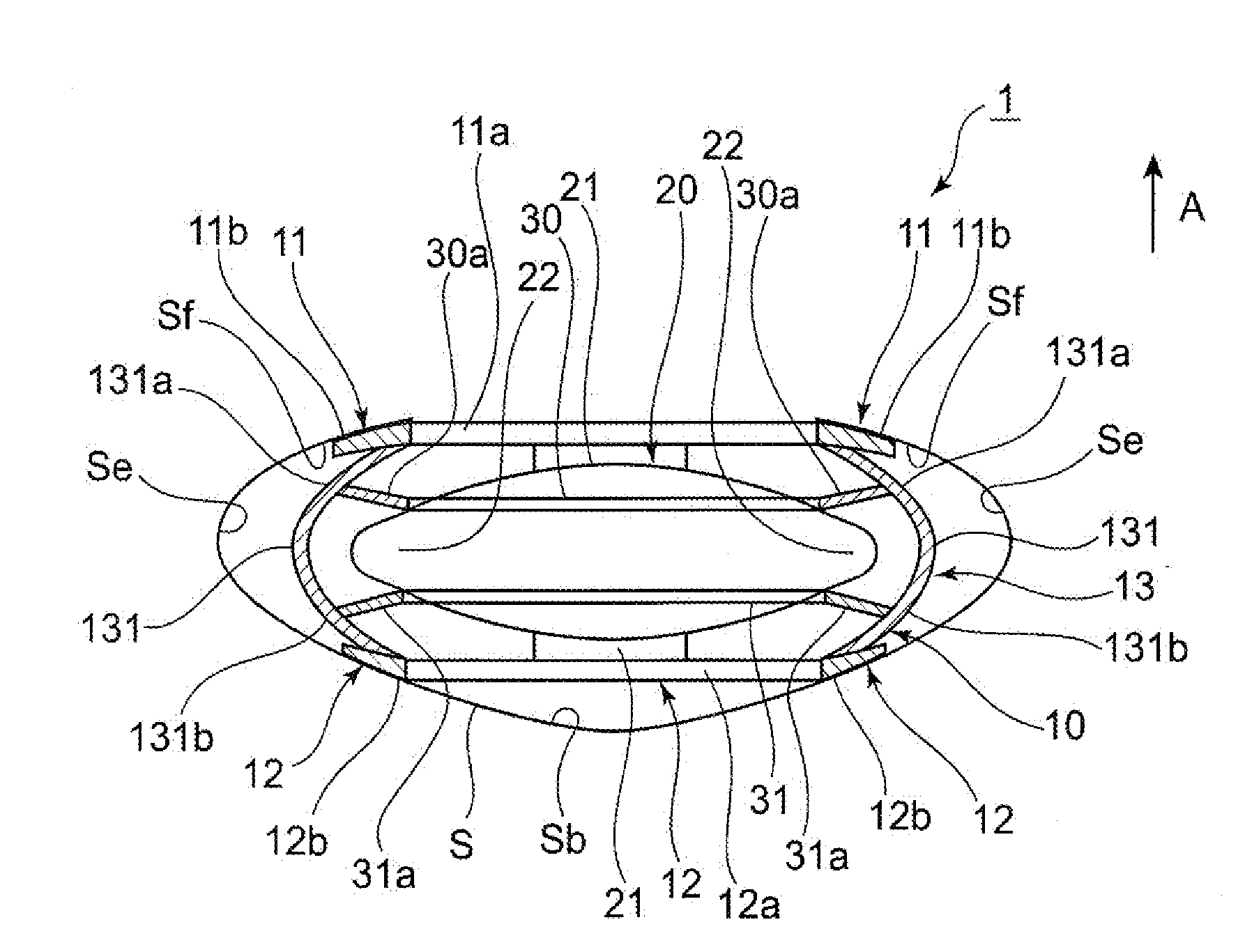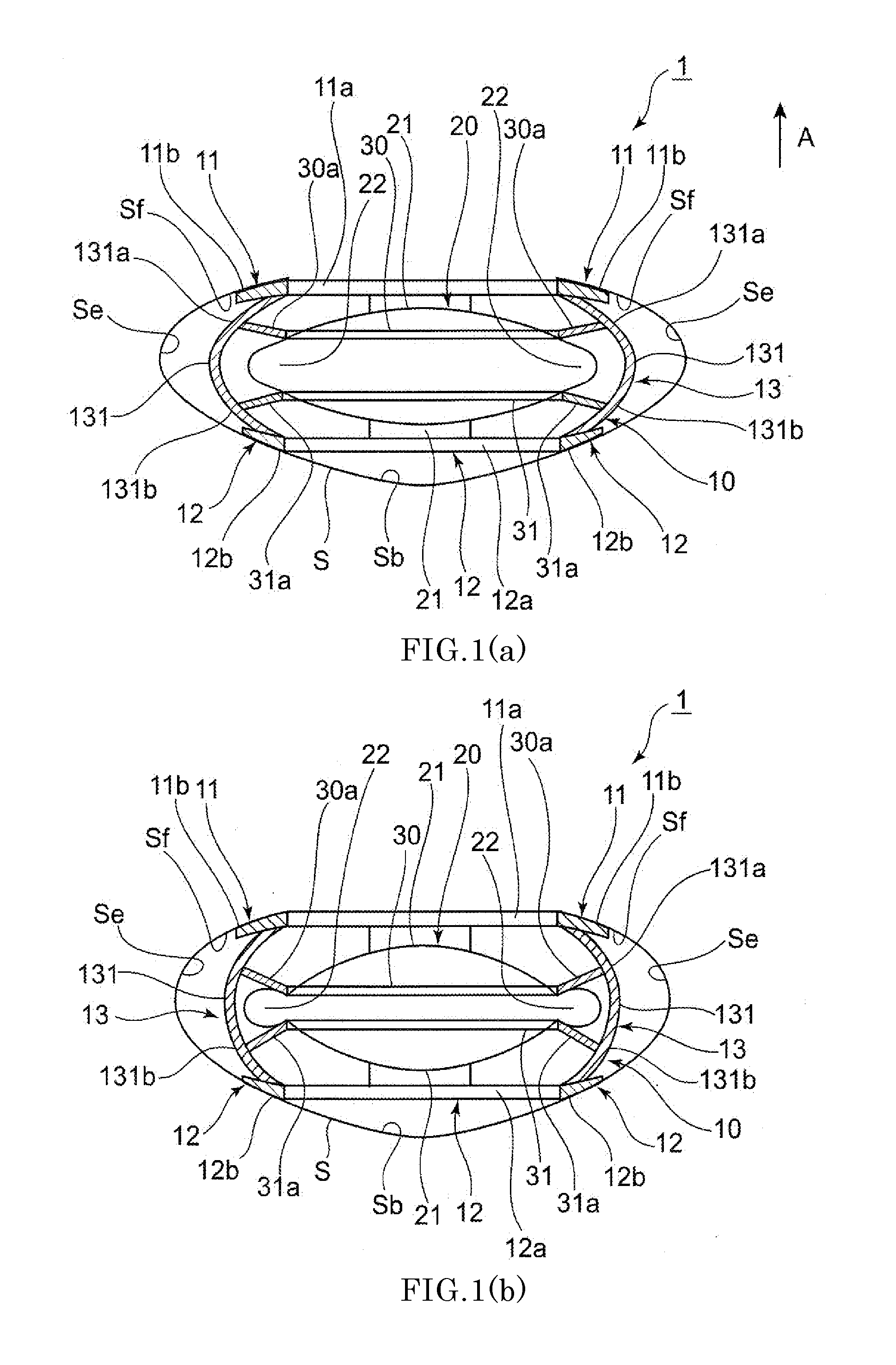Accommodating intraocular lens
a technology for accommodating intraocular lenses and lenses, applied in intraocular lenses, medical science, prosthesis, etc., can solve the problems of inability to accurately exert the accommodation function of the intraocular lens arranged therein, inability to accurately transmit the contraction and relaxation of the ciliary muscles of the ciliary bodies, and inability to accurately convert. , to achieve the effect of reducing the diameter of the lens equator, moderate strength and high accuracy
- Summary
- Abstract
- Description
- Claims
- Application Information
AI Technical Summary
Benefits of technology
Problems solved by technology
Method used
Image
Examples
first embodiment
[0039]Next, a first embodiment of an accommodating intraocular lens according to the present invention will be described with reference to FIG. 1.
[0040]An accommodating intraocular lens 1 includes a lens capsule expanding device (hereinafter referred to as a device 10) and an optical portion 20 disposed inside the device 10. In the following description, the direction indicated by arrow A illustrated in the drawings is defined as a front side and the opposite direction is defined as a rear side.
[Device Configuration]
[0041]As illustrated in FIG. 1, the device 10 is arranged in the lens capsule S of which the anterior capsule Sf is incised during ophthalmic surgeries such as an extracapsular extraction surgery performed as a part of a cataract surgery, a refractive correction surgery, or a presbyopia correction surgery. As illustrated in FIG. 1, the device 10 includes a front supporting portion 11 positioned on the front side in the lens capsule S, a rear supporting portion 12 positio...
second embodiment
[0059]Next, a second embodiment of the accommodating intraocular lens 1 according to the present invention will be described with reference to FIG. 2.
[0060]The optical portion 20 on the front surface is in contact with the inner circumferential portion 11c of the front supporting portion 11 of the lens capsule expanding device 10 whereas the rear ring member 31 on the rear surface is provided in such a manner of being parallel to the circumferential portion 22 of the optical portion 20. The front ring member 30 is not provided unlike the first embodiment.
[0061]Therefore, as illustrated in FIG. 2(a), during distance vision (non-focus accommodation), when the front supporting portion 11 and the rear supporting portion 12 move in the direction closer to each other and the degree of expansion of the connecting portion 13 in the radially outward direction increases, the lower portion 131b of the connecting piece 131 moves in the radially outward direction. In this case, the lateral branc...
third embodiment
[0066]Next, a third embodiment of the accommodating intraocular lens 1 according to the present invention will be described with reference to FIG. 3.
[0067]As illustrated in FIG. 3, the device 10 according to the present embodiment includes a first connecting portion 132 that connects the outer circumferential portions of the front supporting portion 11 and the rear supporting portion 12 and a second connecting portion 133 that connects the inner circumferential portions of the front supporting portion 11 and the rear supporting portion 12. The second connecting portion 133 further includes a front ring connecting portion 133A and a rear ring connecting portion 133B arranged alternately along the circumferential direction.
[0068]The front ring connecting portion 133A includes a plurality of connecting pieces provided at equal intervals along the circumferential direction of the front supporting portion 11 and the rear supporting portion 12, a bent portion 133a is formed at a position ...
PUM
 Login to View More
Login to View More Abstract
Description
Claims
Application Information
 Login to View More
Login to View More - R&D
- Intellectual Property
- Life Sciences
- Materials
- Tech Scout
- Unparalleled Data Quality
- Higher Quality Content
- 60% Fewer Hallucinations
Browse by: Latest US Patents, China's latest patents, Technical Efficacy Thesaurus, Application Domain, Technology Topic, Popular Technical Reports.
© 2025 PatSnap. All rights reserved.Legal|Privacy policy|Modern Slavery Act Transparency Statement|Sitemap|About US| Contact US: help@patsnap.com



